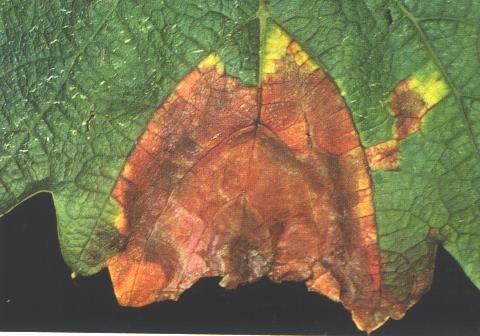Of European origin, Rotbrenner or parasitic vine rot was first identified in the Finger Lakes vineyards in the USA. It is rarely observed in France.
2.4.1.f Rotbrenner disease
What are the symptoms of Rotbrenner on vine leaves?
Rotbrenner is characterized by large polygonal spots. These are bordered by the primary and secondary veins. The first symptoms are generally similar to the "oil spot" facies for downy mildew. They then evolve into yellowing spots surrounded by a lighter border in white grape varieties.
In red grape varieties, spots with a reddish colour surrounded by a purplish band appear. Early outbreaks can cause total defoliation at the base of branches, which can then hinder the ripening process. In the case of late outbreaks, which are quite rare, the damage to leaves is limited, the spots are numerous but smaller and the leaves do not generally drop off.
What are the symptoms of Brenner disease on grape clusters?
The early outbreaks that cause the leaves to drop as described above can cause coulure (shatter), rot and drying of the inflorescences, resulting in reduced yields.
The fungus does not usually attack the rachis (main stem), only the pedicels are affected. In case of severe attacks, the berries can be destroyed and the stalk develops black necroses in an elongated shape. Inflorescences seem to be most susceptible to attacks by the fungus at the stages with 6-8 leaves and 10-12 leaves.
Can symptoms be confused with other diseases?
The first symptoms of Brenner are usually very similar to the "oil spot" facies found with downy mildew and may therefore be confused with the latter. The spots can also resemble spray burns or "sunburn".
What is the biology of this fungus?
The fungus responsible for Rotbrenner (Pseudopezicula tracheiphila) is preserved as mycelia in dead leaves and is resistant to cold winter temperatures. However, mild winters may favour the development of competing microflora. At the beginning of spring, the fungus produces apothecia which mature over a period of one to one and a half months, from April to July-August. The ascospores, released by rainfall, are then dispersed by the wind, reaching the vine's leaves where they germinate in the presence of water.
A dry period followed by a rainy period of two to four days provides ideal conditions for contamination. The germ tube then penetrates the epidermis and remains latent for two to four weeks before invading the vascular system and causing symptoms.
What practices favour Rotbrenner disease? What preventive measures are there?
-
Plant material choice: some grape varieties are more vulnerable than others to Brenner disease, notably Chardonnay, Chasselas, Carignan, Pinot and Riesling. Prophylactic solutions : In high risk areas, selection of varietals that are non-vulnerable (Cinsault, Clairette, Grenache, Mourvèdre, Ugni blanc).
-
Vigor control and vineyard management: humidity and precipitations provide favorable conditions for the establishment of the fungus, a strong vigor expressed by high foliar density for example can favor the fungus contamination. Not burying the leaves can cause the dissemination of the disease, as well as the improper implementation of certain green operations that favor a humid microclimate (leaf removal, thinning, etc.). Prophylactic solutions: Avoiding vineyard management or pruning methods that favor large leaf surface close to the ground, tilling the soil after leaf fall in at-risk areas buries and destroys sources of inoculum.
Extract from Vigne Vin Occitanie.
What treatments are available to combat this fungus?
In organic winegrowing, only copper and sulphur, which do have some effect, are authorized.
Prevention is key to combat Rotbrenner. In low-risk areas, protection is generally ensured by traditional cover treatments (downy mildew, powdery mildew).
In high-risk areas, the Bulletins de Santé du Végétal (Plant Health Bulletins) provide information about the best timing for the initial treatments. Continuous protection must then be maintained until the end of the ascospore projection.


